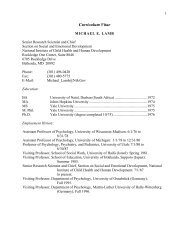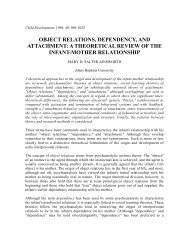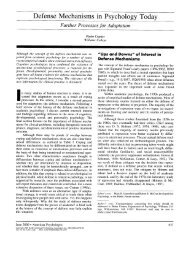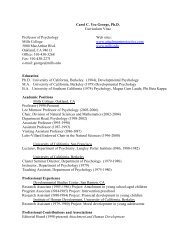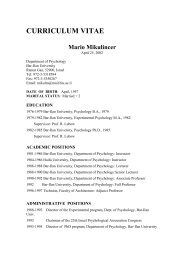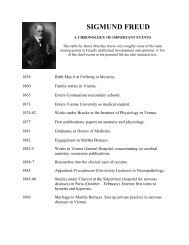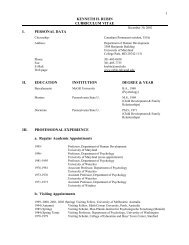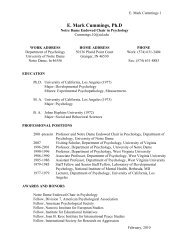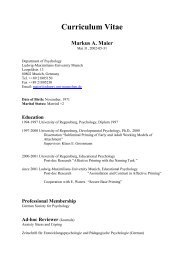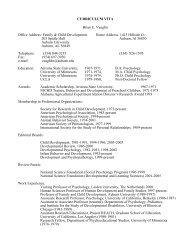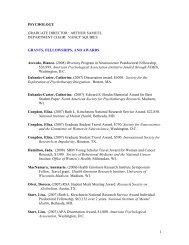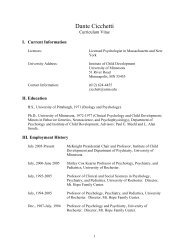Friendships and Adaptation in the Life Course - Psychology ...
Friendships and Adaptation in the Life Course - Psychology ...
Friendships and Adaptation in the Life Course - Psychology ...
You also want an ePaper? Increase the reach of your titles
YUMPU automatically turns print PDFs into web optimized ePapers that Google loves.
356 HARTUP AND STEVENS<br />
als trigger changes <strong>in</strong> relationships <strong>and</strong> that <strong>the</strong>se changes extend<br />
through <strong>the</strong> life course. For example, (a) among very young<br />
children, new coord<strong>in</strong>ations <strong>and</strong> comb<strong>in</strong>ations <strong>in</strong> memory<br />
emerge at about 2 years of age, appear<strong>in</strong>g to serve as a basis for<br />
an <strong>in</strong>crease of coord<strong>in</strong>ation <strong>and</strong> collaboration <strong>in</strong> <strong>the</strong> <strong>in</strong>teraction<br />
between toddlers <strong>and</strong> <strong>the</strong>ir friends (Brownell, 1986); (b)<br />
changes associated with puberty trigger <strong>in</strong>creases <strong>in</strong> <strong>in</strong>timacy<br />
between opposite-gender friends but not same-gender friends<br />
(Sharabany, Gershoni, & Hofman, 1981 ); <strong>and</strong> (c) when strength<br />
<strong>and</strong> mobility decl<strong>in</strong>e <strong>in</strong> old age, one' s friends must <strong>in</strong>itiate social<br />
contact <strong>and</strong> activities, <strong>the</strong>reby chang<strong>in</strong>g relationship reciproci-<br />
ties (O'Connor, 1993; Rawl<strong>in</strong>s, 1992).<br />
To consider friendships across <strong>the</strong> life course requires <strong>the</strong><br />
differentiation of deep structure, which characterizes <strong>the</strong>se rela-<br />
tionships, from surface structure. We use deep structure to refer<br />
to <strong>the</strong> social mean<strong>in</strong>g (essence) of relationships <strong>and</strong> surface<br />
structure to refer to <strong>the</strong> social exchanges that characterize <strong>the</strong>m<br />
at any given moment or <strong>in</strong> any given situation--a convention<br />
that is similar to <strong>the</strong> one used <strong>in</strong> l<strong>in</strong>guistics (Chomsky, 1965).<br />
The friendship deep structure can be identified by researchers<br />
ask<strong>in</strong>g participants to describe a friend or friends--especially<br />
an ideal or hypo<strong>the</strong>tical friend--<strong>and</strong> <strong>the</strong>n content analyz<strong>in</strong>g <strong>the</strong><br />
results. Accord<strong>in</strong>gly, among young children, friendship expecta-<br />
tions have been found to center ma<strong>in</strong>ly on common activities<br />
<strong>and</strong> concrete reciprocities ("We play." "And I give <strong>the</strong>m food,<br />
so <strong>the</strong>y give me food back"; Goodnow & Burns, 1985, p. 120).<br />
School-aged children describe friends as underst<strong>and</strong><strong>in</strong>g, loyal,<br />
<strong>and</strong> trustworthy; children expect to spend time with <strong>the</strong>ir friends,<br />
share <strong>in</strong>terests, <strong>and</strong> engage <strong>in</strong> self-disclosure with <strong>the</strong>m ("A<br />
good friend is someone who likes you <strong>and</strong> spends time with<br />
you <strong>and</strong> forgives you <strong>and</strong> doesn't actually bash you up"; p.<br />
120). Children do not use words like <strong>in</strong>timate to describe <strong>the</strong>ir<br />
friends, but such constructs beg<strong>in</strong> to differentiate <strong>the</strong>se relation-<br />
ships shortly before adolescence (Bigelow, 1977; Selman,<br />
1980). Older <strong>in</strong>dividuals describe an ideal friend ma<strong>in</strong>ly as<br />
be<strong>in</strong>g supportive (dependable, underst<strong>and</strong><strong>in</strong>g, <strong>and</strong> accept<strong>in</strong>g), a<br />
confidant, <strong>and</strong> trustworthy. Most important, high school seniors,<br />
newlyweds, middle-aged parents, <strong>and</strong> soon-to-be retirees differ<br />
relatively little from one ano<strong>the</strong>r <strong>in</strong> <strong>the</strong>ir emphasis on <strong>the</strong>se<br />
reciprocities when <strong>the</strong>y describe an ideal friend. Similarity be-<br />
tween friends (shar<strong>in</strong>g <strong>in</strong>terests, experiences, <strong>and</strong> activities as<br />
well as communicative compatibility) is regarded, however, as<br />
an important friendship attribute among adolescents but de-<br />
creases subsequently (L. Weiss & Lowenthal, 1975).<br />
Close exam<strong>in</strong>ation of <strong>the</strong>se results reveals differences as well<br />
as similarities <strong>in</strong> <strong>the</strong> manner <strong>in</strong> which friends are described by<br />
younger <strong>and</strong> older <strong>in</strong>dividuals. Differences occur ma<strong>in</strong>ly <strong>in</strong> <strong>the</strong><br />
number of psychological constructs used, complexity <strong>and</strong> orga-<br />
nization of <strong>in</strong>formation <strong>and</strong> ideas, <strong>and</strong> flexibility with which<br />
this <strong>in</strong>formation is used to describe a friend, These age differ-<br />
ences are similar to those recorded <strong>in</strong> person perceptions (Lives-<br />
ley & Bromley, 1973), which probably reflect general cognitive<br />
development. Similarities across age occur <strong>in</strong> <strong>the</strong> extent to which<br />
reciprocity <strong>and</strong> mutuality emerge <strong>in</strong> <strong>the</strong> mean<strong>in</strong>g structure. Reci-<br />
procity does not have narrow connotations <strong>in</strong> <strong>the</strong>se descriptions;<br />
most <strong>in</strong>dividuals do not describe friendships as exchange rela-<br />
tionships <strong>in</strong> which <strong>in</strong>puts <strong>and</strong> resource exchanges must be equiv-<br />
alent or one <strong>in</strong>dividual's behavior must exactly match ano<strong>the</strong>r's.<br />
Never<strong>the</strong>less, children <strong>and</strong> adults of all ages consider <strong>the</strong>se rela-<br />
tionships to be marked by reciprocation, that is, mutuality--<br />
<strong>the</strong> giv<strong>in</strong>g <strong>and</strong> tak<strong>in</strong>g, <strong>and</strong> return<strong>in</strong>g <strong>in</strong> k<strong>in</strong>d or degree. On this<br />
basis, <strong>the</strong>n, we argue that <strong>the</strong> friendship deep structure <strong>in</strong> West-<br />
ern cultures is best described as "symmetrical reciprocity" (see<br />
H<strong>in</strong>de, 1979; <strong>and</strong> Youniss, 1980).<br />
Because reciprocity constitutes <strong>the</strong> friendship deep structure<br />
across <strong>the</strong> life course, certa<strong>in</strong> outcomes or consequences should<br />
be evident at all ages. Social reciprocities should be significant<br />
sources of security (Bowlby, t969), self-worth (Sullivan,<br />
1953), <strong>and</strong> well-be<strong>in</strong>g (R. S. Weiss, 1973). These conditions,<br />
<strong>in</strong> turn, should support successful cop<strong>in</strong>g, especially with devel-<br />
opmental transitions such as school entrance, puberty, workforce<br />
entrance, marriage, child bear<strong>in</strong>g, spouse' s death, <strong>and</strong> retirement<br />
(Magnusson, Statt<strong>in</strong>, & Allen, 1985). On <strong>the</strong> basis that friend-<br />
ship reciprocities support cop<strong>in</strong>g <strong>in</strong> this fashion, one expects<br />
<strong>the</strong>se relationships to promote good outcomes regardless of age.<br />
Surface structures--<strong>the</strong> actual exchanges that occur between<br />
friends--differ from situation to situation <strong>and</strong> from early child-<br />
hood to old age. Social reciprocities between two toddlers, for<br />
example, are manifested ma<strong>in</strong>ly <strong>in</strong> time spent toge<strong>the</strong>r <strong>and</strong> con-<br />
nected <strong>in</strong>teractions (Howes, 1989). Reciprocities between k<strong>in</strong>-<br />
dergarten friends are more elaborate socially but rema<strong>in</strong> basi-<br />
cally concrete, consist<strong>in</strong>g of play <strong>and</strong> shar<strong>in</strong>g (Howes, 1983).<br />
Reciprocities among adolescent friends consist of common ac-<br />
tivities (especially socializ<strong>in</strong>g), augmented by self-disclosure<br />
<strong>and</strong> expectations of loyalty <strong>and</strong> trust (Berndt, 1989). Reciproci-<br />
ties among adult friends are centered on work activities, <strong>and</strong><br />
many friendships become "fused" or "blended" with work<br />
(Hess, 1972; W<strong>in</strong>stead, Derlega, & Montgomery, 1995). O<strong>the</strong>r<br />
fusions occur with marriage; husb<strong>and</strong>s <strong>and</strong> wives frequently<br />
share friends with whom issues <strong>in</strong> marriage <strong>and</strong> family relations<br />
are stressed (Hess, 1972; Rawl<strong>in</strong>s, 1992). Reciprocities among<br />
older persons are more separated from family <strong>and</strong> work but<br />
concern support issues <strong>and</strong> companionship. Surface structures<br />
at this time <strong>in</strong>clude friends exchang<strong>in</strong>g letters <strong>and</strong> gifts, talk<strong>in</strong>g<br />
on <strong>the</strong> telephone, do<strong>in</strong>g favors for one ano<strong>the</strong>r, <strong>and</strong> express<strong>in</strong>g<br />
affection <strong>and</strong> mutual respect (Rawl<strong>in</strong>s, 1992; Shea, Thomp-<br />
son, & Blieszner, 1988). What friends talk about <strong>and</strong> what <strong>the</strong>y<br />
do with one ano<strong>the</strong>r thus change with age <strong>and</strong> circumstance.<br />
We believe that <strong>the</strong>se changes <strong>in</strong> surface structure ma<strong>in</strong>ly<br />
reflect changes <strong>in</strong> <strong>the</strong> developmental tasks (Havighurst, 1953)<br />
confront<strong>in</strong>g <strong>the</strong> <strong>in</strong>dividuals <strong>in</strong>volved. So, among young children,<br />
friendship reciprocities support <strong>the</strong> acquisition of new social<br />
skills, especially expertise <strong>in</strong> cooperation <strong>and</strong> o<strong>the</strong>r socially co-<br />
ord<strong>in</strong>ated skills (e.g., conflict resolution). Among older children<br />
<strong>and</strong> adolescents, <strong>the</strong> emphasis shifts to <strong>in</strong>timacy <strong>and</strong> o<strong>the</strong>r ex-<br />
changes that support a sense of self-identity, sensitivity with<br />
respect to <strong>the</strong> needs of o<strong>the</strong>rs, <strong>and</strong> ma<strong>in</strong>tenance of mutually<br />
oriented relationships with "agemates"--<strong>in</strong>clud<strong>in</strong>g members<br />
of both <strong>the</strong> same <strong>and</strong> opposite genders (Sullivan, 1953). Among<br />
young adults, friendshiPS center on a new collection of develop-<br />
mental tasks--work <strong>and</strong> family issues (Hess, 1972). F<strong>in</strong>ally,<br />
when older <strong>in</strong>dividuals confront major life transitions that re-<br />
quire reorganization of one's lifestyle <strong>and</strong> expectations, friend-<br />
ship content changes once aga<strong>in</strong>. Clearly, <strong>the</strong> socializ<strong>in</strong>g func-<br />
tions of <strong>the</strong>se relationships are closely tied to <strong>the</strong> developmental<br />
challenges that <strong>the</strong> <strong>in</strong>dividuals <strong>in</strong>volved face, whatever <strong>the</strong>ir age.<br />
Some researchers suggested that friendship surface structures<br />
are ma<strong>in</strong>ly socializ<strong>in</strong>g <strong>in</strong> childhood <strong>and</strong> adolescence because<br />
<strong>the</strong>y support <strong>in</strong>novation <strong>in</strong> both social underst<strong>and</strong><strong>in</strong>g <strong>and</strong> social<br />
skill, but <strong>the</strong>y are ma<strong>in</strong>ly susta<strong>in</strong>ed <strong>in</strong> old age, through which



